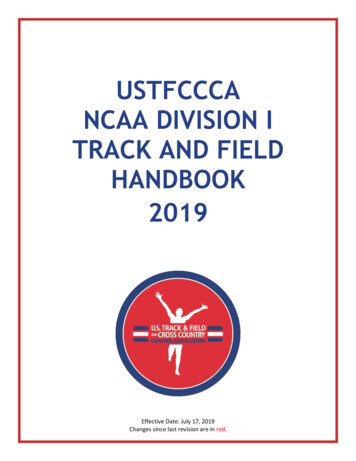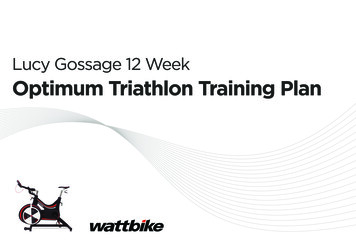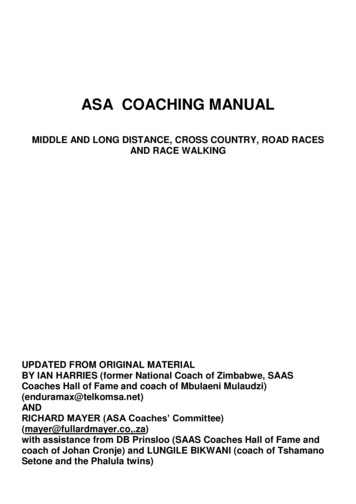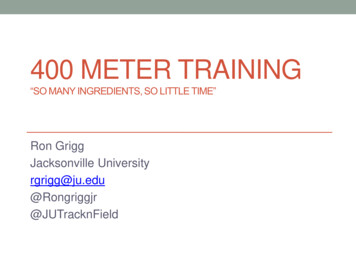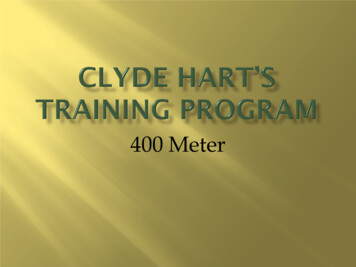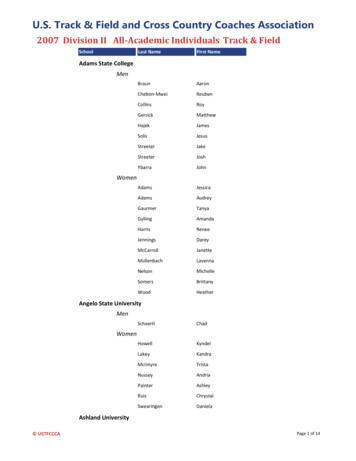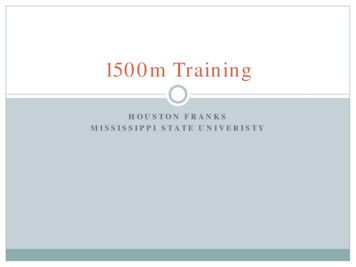
Transcription
1500m TrainingHOUSTON FRANKSMISSISSIPPI STATE UNIVERISTY
1500m Training Influence
Profiling a 1500m Runner Matching individual athlete skill sets with thephysiological demands of the event Good combination of speed and endurance High VO2 Max (aerobic power) Good buffering capacity (anaerobic)
Energy System Contributions
Percentage of VO2 Max
Cross CountryPhases of TrainingDurationEmphasisApplicationsTransition2 Weeks1. RecoveryEasy to moderate continuous runs2. Aerobic ThresholdGeneral Prep4-6 Weeks1. Aerobic ThresholdBegin to increase length of distance runs2. Lactate ThresholdIntroduce the "long run" back to weekly routine3. Strength/FlexibilityIntroduce strides after runs to improve leg turnoverProgressive RunsWeights/Circuits/CoreSpecific PrepPre-Competition6-8 Weeks5-6 Weeks1. Lactate ThresholdIntroduce Fartlek, Tempo Runs, Hill Sessions2. vVO2Interval Sessions (w/medium intensity, very short rest)3. Strength/FlexibilityCan begin racing during this phase1. vVO2Intervals primarily 2-6 minutes in length w/short rest2. Lactate ThresholdMaintain Aerobic Base3. Lactate ToleranceUsually during the middle of racing seasonReduce, but maintain LT Work (EX: Tempo Runs)Continue Hill Session of varying lengthsCompetition2-4 Weeks1. vVO2Length of Intervals 2-4 Minutes in length with longer rest2. Lactate ToleranceIntensity stays high, volume decreases3. Lactate ThresholdReduce aerobic running and length of "long runs"End of Racing Season
Indoor TrackPhases of TrainingDurationEmphasisApplicationsTransition1 Week1. RecoveryEasy to moderate continuous runs2. Aerobic ThresholdGeneral Preparation3 Weeks1. Aerobic ThresholdBegin to increase length of distance runs2. Lactate ThresholdIntroduce the "long run" back or lengthen to weekly routine3. Lactate ToleranceIntroduce strides after runs to improve leg turnoverProgressive RunsHill SessionsSpecific Preperation4 Weeks1. vVO2 MaxUse Fartlek, Tempo Runs, Hill Sessions2. Lactate ThresholdInterval Sessions (w/medium intensity, short rest)3. Lactate ToleranceCan begin racing during this phaseUse some races as workouts, often racing shorter race distancesPre-Competition4 Weeks1. vVO2 MaxIntervals primarily 2-6 minutes in length2. Lactate ToleranceMaintain Aerobic Base3.Usually during the middle of racing seasonLactate ThresholdReduce, but maintain LT Work (EX: Tempo Runs)Intenshity of workouts increases, weekly volume decreasesCompetition2-4 Weeks1. Lactate ToleranceLength of Intervals 2-4 Minutes in length with longer rest2. vVO2 MaxIntensity stays high, volume decreases slightly3. RecoveryReduce aerobic running and length of "long runs"End of Racing Season
Outdoor TrackPhases of TrainingDurationEmphasisApplicationsGeneral Preparation3 Weeks1. Aerobic ThresholdBegin to increase length of distance runs2. Lactate ThresholdIntroduce the "long run" back to weekly routine3. vVO2Introduce strides after runs to improve leg turnoverProgressive RunsSpecific PreperationPre-Competition4 Weeks4-6 Weeks1. vVO2 MaxIntroduce Fartlek, Tempo Runs, Hill Sessions2. Lactate ThresholdInterval Sessions (w/medium intensity, very short rest)3. Lactate ToleranceCan begin racing during this phase1. vVO2Intervals primarily 2-6 minutes in length2. Lactate ToleranceMaintain Aerobic Base3.Usually during the middle of racing seasonLactate ThresholdReduce, but maintain LT Work (EX: Tempo Runs)Intenshity of workouts increases, weekly volume decreasesCompetition4-6 Weeks1. Lactate ToleranceLength of Intervals 2-4 Minutes in length with longer rest2. vVO2 MaxIntensity stays high, volume decreases3. RecoveryReduce aerobic running and length of "long runs"End of Racing Season
Aerobic Training Methods Recovery Runs – typically 30-45 minutes in duration(target pace – 65-75% vVO2) Aerobic Development Runs – typically 45-70minutes in duration (target pace – 70-80% vVo2) Long Runs – typically 70-100 minutes (someindividuals may be as long as 120 min.) (target pacesame as Aerobic Development Runs)
Aerobic Training Methods cont. Lactate Threshold Runs (usually run progressive innature): Long Tempo – 8-10 Miles – (target pace 80-85% vVO2)Medium Length Tempo – 5-7 Miles – (target pace 85-88%vVO2)Short Tempo – 3-4 Miles – (target pace 88-92% vVO2)Lactate Threshold Intervals – Usually 5-15 minutes induration, with very short recovery time b/reps (usually 1-2min.). (Target time depends on total volume of session).
Aerobic Training Methods cont. VO2 Max Intervals – 2-6 minutes long in duration(600m – up to 2k) – COMBINE ZONE (training hasaerobic and anaerobic contributions andadaptations) 95% vVO2 – (approx. 8k race pace) – ¼ to ½ time recoveryb/reps – up to 10k in total volume97% vV02 – (approx. 5k race pace) – ½ time recovery b/reps– up to 8k in total volume100% vVO2 – (approx. 3k race pace) – equal rest b/reps – upto 6k in total volume
Anaerobic Training Methods 1500m Pace work (110% vV02 Max) – typically200m-1000m in length. Typically equal to doublerest of duration run. 800m pace work (120% vVO2 Max) – typically150m-600m in length. Rest is enough to maintaindesired velocity. Lactate Tolerance – Short/fast intervals run in setswith very short recovery b/reps, but longer restb/sets. Example: 4 x 3 x 200m, at 29-31, 30 sec. b/reps, 8 min. b/sets
Training Paces Fractionalization of vVO2 Test for vVO2 – Ex: 2 Mile Time Trial or 10 minutetest Important to get “Date vVO2” I often use some workouts that we have done foryears: Example: 1000m repeats or mile repeats.
Example of Training Paces Marta Freitas – Summer 2017 – 65% vVO2 – 7:26.1270% vVO2 – 6:54.2675% vVO2 – 6:26.6480% vVO2 – 6:02.4785% vVO2 – 5:41.1588% vVO2 – 5:29.5290% vVO2 – 5:22.2092% vVO2 – 5:15.2095% vVO2 – 5:05.2497% vVO2 – 4:58.95100-102% vVO2 – 4:44.29 – 4:49.98 (2:55-3:01 / 1000m)110% vVO2 – 4:23.62 (65-66/400)120% vVO2 – 4:01.65 (29-30/200 or 60/400)
Race Predictions based on vVO2(Marta Freitas – Summer 2017) 800m – 2:00.12 1500m – 4:05.71 3000m – 8:49 – 9:00 5000m – 15:28 10,000m – 32:38*Does not necessarily mean they can run all of these,just means they need to do workouts like they can runthese
Multi-Pace Training Cycle Typically 14 day cycle Within the 14 day cycle we will hit different trainingpaces. What those paces are differ depending on thetime of year. Helps reduce monotony Allows for adequate recovery between “hard”sessions
Example Cross Country (Fall )14 Day Cycle M-50-60 min. run, followed by weights/circuits T-4-5x Mile, 3 min. b/reps W-2 Recovery runsTh-50-60 min. run, followed by weights/circuits F- Long Tempo Run S -2 Recovery Run S – OFF or light run M-50-60 min. run, followedby weights/circuitsT-6x1000m, 3 min. b/repsW-2 recovery runs, followedby weights/circuitsTh-Pre-RaceF – CC RaceS- Recovery RunS- Long Run
Example of Primary Session in 14 day Cycle Track Prep/Early Track Season Alactic Work – Ex:4 x 30m flys, 2 x 60m flys, aerobic run after the flywork110% vVO2 Max, approx. 1500m pace. Ex: 10 x 400m with 2min.b/reps. (start with 2 min. b/reps and work our way down to 60 sec.as buffering capacity improveLactate Threshold: Ex: 4 Mile Tempo Run at 88-90% vVO2.followed by a few “strides” 150’s or 200’sLong Run – Approx. 90 minutes (individualized for the athlete)97% VO2 – Ex: 5 x 1200m at approx. 5k pace, 2 min. b/repss)120% VO2 Max: 16-20 x 200m at 800m pace, 200m jog b/reps (maybe done in sets if needed initially)Long Run with Lact. Thr. in the middle: Ex: 3 miles easy, 5-6 miles atLT (approx: 85% vVO2), 3 miles easy
Example of Primary Session in 14 day Cycle Track Prep/Middle Track Season Alactic Work – Ex:4 x 30m flys, 2 x 60m flys, aerobic run after the flywork110% vVO2 Max, approx. 1500m pace. Ex: 10 x 400m with 1 min.b/reps. (insert a couple of 500’s in the middle later) ORLactate Threshold: Ex: 4 Mile Tempo Run at 88-90% vVO2.followed by a few “stride” 150’s or 200’sLong Run – Approx. 90 minutes (individualized for the athlete)100% VO2 – Ex: 5-6 x 1000m at approx. 3k pace, 3 min. b/reps)120% VO2 Max: 3 x 500m, 5 min. b/reps, rest 6-8 min. then do 5 x300m, 3 min. b/repsLong Run with Lact. Thr. in the middle: Ex: 4 miles easy 4 miles atLT (approx: 85% vVO2), 4 easy
Example of 14 day Cycle Track Prep/Late Track Season Alactic Work – Ex:3 x 30m flys, 2 x 60m flys, 1 x 150m110% vVO2 Max, approx. 1500m pace. Ex: 2 x 800/400/300, 3 min./ 90 sec. b/reps, 8 min. b/sets OR 2 x 1000m, 8 min.b/repsLactate Tolerance: 3 x 400/200, 60 sec. b/reps, 6-8 min. b/sets OR 2x 4 x 200m, 30 sec. b/repsLactate Threshold: Ex: 4 Mile Tempo Run at 88-90% vVO2.followed by a few “stride” 150’s or 200’s100% VO2 – Ex: 4-5 x 1000m at approx. slightly faster than3k pace,3 min. b/reps,120% VO2 Max: 2 x 400/200/200/200, 3 min./90 sec. b/reps, 6-8min. b/setsLong Run – Approx. 80-90minutes (individualized for the athlete)
Advantages of 14 day cycle Allows for a bit more flexibility with the cycle if and extra day of recovery is needed between “hard”sessionsWorks well with our racing schedule most of the time(race every other week a lot)Can hit the all of the major training parameters within the cycle fairly easily.Helps avoid monotony of trainingSome people do a “speed” week and a “endurance”week, I try to mix
Training Specificity Match the training to the athlete’s skill set as well astactically how they race I break the race down to 4 parts 800/400/200/100First 800 is about establishing/realizing what type of race it isgoing to be (fast time vs. tactical) and getting in a good position Next 400 is about being at or very close to the position you want tobe in going into the “critical zone” (last 300m). Maintain goodposition OR get there if first 800 has not gone as well as planned The next 200 is a significant pace increase “push for home” buttrying to keep one last gear if possible The last 100m is the “sprint” finish
Training Specificity Set workouts up to prepare for what you want thefirst 800 to be, what the next 400 needs to be, andthen what the critical zone (last 300) needs to be Don’t worry too much about the last 300 until youhave the first 1200 done
Training Specificity cont. Has to be work done handle the fast pace in themiddle of the race aerobically. That is where thelong interval work come in. The goal is to get to1200m as aerobically as possible and staying “clean”as possible It takes us a minimal of 8-12 weeks to get bufferingcapacity to where we want it. So some anaerobicglycolytic work is introduced early in the trackpreparation
Training to Train vs. Training to Race T2T – higher volumes, typically shorter recovery,more general in nature. T2R – Longer (more significant duration) intervalswithin the session, with longer recovery b/reps Example: 10 x 400m, 60 sec. b/reps at goal 1500m pace2 x 1000m, 8 min. b/reps at goal 1500m paceExample: 20 x 200m at 30-32, 200m jog b/reps2 x 400/200/200/200 at 60 / 29-30 / 29-30 /29-30, 3 min.,and 90 sec. b/reps, 8-10 min. b/sets
Individualizing Training Always focus on athletes strength, while still workingon their weaknesses. Example: Rhian Price vs. Marta FreitasVery similar athletes, but very different backgrounds Rhian’s background was a lot of basic aerobic runs. Good aerobicefficiency, under developed aerobic power, very little background instructured/progressive track sessions, no weight room work Marta’s background much like a 400m runner. Very ballistic,anaerobically developed, aerobically very underdeveloped. Veryhigh developed weight room program Training now is similar, but still has some major differences Rhian runs slightly more Lactate Threshold work, a bit less“sprinting”, ran more mileage until recently (now pretty similar) Marta has more advanced weight room program, sprints moreoften and with more volume
Individual Training cont. Psychological Difference Gear training to build confidenceSet athletes up to succeedExample: Ffion Price vs. Rhian Price (identical twins)Concentration levels were different in the beginning Same training concepts, but when Ffion came to MSU she was not asdeveloped aerobically (proven in the lab) and we had to use “bridgingworkouts”, but more developed anaerobically initially Breakdown workouts to ensure success and then progress theworkoutsEx: Long Tempo vs. LT Intervals or Fartlek Starting intervals at a length that the athlete can maintain the desiredintensity and/or velocity Ex: progressing vVO2 work from 600’s to800’s to 1000’s, etc.
Critical Zone Training In the 1500m I identify the last 300 (200/100) as thecritical Zone of the 1500m. That is where medalsand “places” are decided First goal is to get to 1200 as “clean” as possible Clean does NOT mean slow Second goal is to have the “speed reserve” to run thelast 300 like it “needs” to be run For men in the NCAA that is 39 sec (27-12) For women in the NCAA that is 46 (31-14) Elite/Pro level is faster (around 37 and 43)
The End
General Prep . 4-6 Weeks . 1. Aerobic Threshold : Begin to increase length of distance runs . 2. Lactate Threshold . Introduce the "long run" back to weekly routine . 3. Strength/Flexibility . Introduce strides after runs to improve leg turnover . Progressive Runs . Weights/Circuits/Core . Specific Prep . 6-8 Weeks . 1. Lactate Threshold
